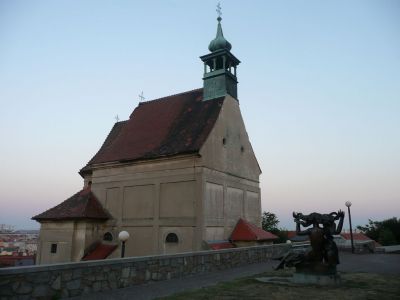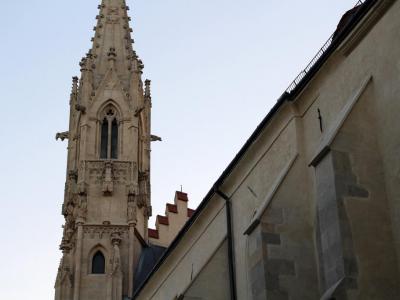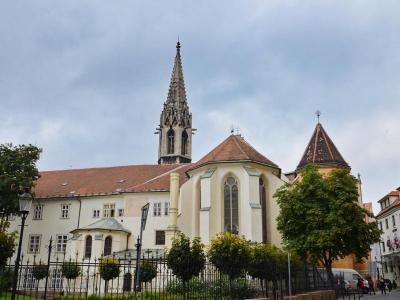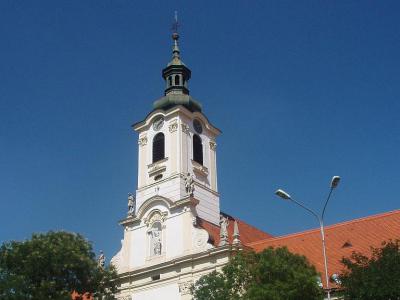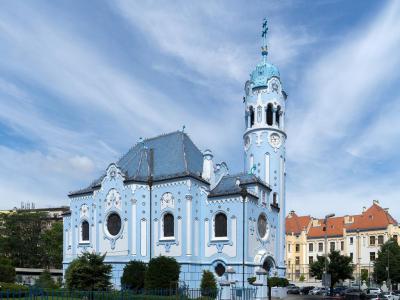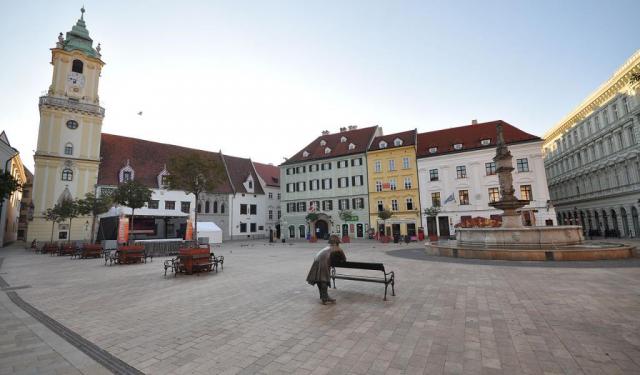
Historical Churches (Self Guided), Bratislava
Although somewhat modest in terms of sights, compared to the neighboring Vienna or Prague, the capital of Slovakia, Bratislava, does have a collection of historical churches that may be of interest to lovers of religious architecture.
Perhaps one of the most prominent landmarks in this area is Saint Martin's Cathedral. Dating back to the mid-15th century, this Gothic-style temple with a towering spire has witnessed numerous significant events in Slovakian history, including coronations of kings.
Another notable site is the Church of Saint Nicholas, located in the Old Town. This Baroque-style church showcases impressive interior decorations and ornate altars.
The Church and Nunnery of the Order of the Sisters of Saint Clare is a serene sanctuary tucked away from the bustle amid the city center. Founded in the early 13th century, this place offers a glimpse into the religious life of the medieval period.
Visitors can also explore the Capuchin Church, known for its distinctive ivory exterior, and the Trinitarian Church of Bratislava, featuring a striking pink-colored, concave facade.
The Bratislava Franciscan Church, with its elegant architecture, stands as a testament to the Franciscan order's presence in the city since the late 1200s.
The Church of Merciful Brothers, with its tranquil atmosphere, provides a peaceful retreat for contemplation.
Finally, the Blue Church, officially known as the Church of Saint Elizabeth, captivates with its sky-blue facade and Art Nouveau design, offering a unique architectural experience.
Historical churches are an invaluable part of Bratislava's cultural tapestry. A visit to these sacred sites is a fascinating journey through centuries of religious and architectural heritage. Our self-guided walk promises to enrich your understanding of the city's past and present.
Perhaps one of the most prominent landmarks in this area is Saint Martin's Cathedral. Dating back to the mid-15th century, this Gothic-style temple with a towering spire has witnessed numerous significant events in Slovakian history, including coronations of kings.
Another notable site is the Church of Saint Nicholas, located in the Old Town. This Baroque-style church showcases impressive interior decorations and ornate altars.
The Church and Nunnery of the Order of the Sisters of Saint Clare is a serene sanctuary tucked away from the bustle amid the city center. Founded in the early 13th century, this place offers a glimpse into the religious life of the medieval period.
Visitors can also explore the Capuchin Church, known for its distinctive ivory exterior, and the Trinitarian Church of Bratislava, featuring a striking pink-colored, concave facade.
The Bratislava Franciscan Church, with its elegant architecture, stands as a testament to the Franciscan order's presence in the city since the late 1200s.
The Church of Merciful Brothers, with its tranquil atmosphere, provides a peaceful retreat for contemplation.
Finally, the Blue Church, officially known as the Church of Saint Elizabeth, captivates with its sky-blue facade and Art Nouveau design, offering a unique architectural experience.
Historical churches are an invaluable part of Bratislava's cultural tapestry. A visit to these sacred sites is a fascinating journey through centuries of religious and architectural heritage. Our self-guided walk promises to enrich your understanding of the city's past and present.
How it works: Download the app "GPSmyCity: Walks in 1K+ Cities" from Apple App Store or Google Play Store to your mobile phone or tablet. The app turns your mobile device into a personal tour guide and its built-in GPS navigation functions guide you from one tour stop to next. The app works offline, so no data plan is needed when traveling abroad.
Historical Churches Map
Guide Name: Historical Churches
Guide Location: Slovakia » Bratislava (See other walking tours in Bratislava)
Guide Type: Self-guided Walking Tour (Sightseeing)
# of Attractions: 8
Tour Duration: 2 Hour(s)
Travel Distance: 2.5 Km or 1.6 Miles
Author: hollyg
Sight(s) Featured in This Guide:
Guide Location: Slovakia » Bratislava (See other walking tours in Bratislava)
Guide Type: Self-guided Walking Tour (Sightseeing)
# of Attractions: 8
Tour Duration: 2 Hour(s)
Travel Distance: 2.5 Km or 1.6 Miles
Author: hollyg
Sight(s) Featured in This Guide:
- St. Martin's Cathedral
- Church of St. Nicholas
- Church and Nunnery of the Order of the Sisters of St. Clare
- Capuchin Church
- Trinitarian Church of Bratislava
- Bratislava Franciscan Church
- The Church of Merciful Brothers
- Blue Church
1) St. Martin's Cathedral (must see)
In the town's early history, worshipping was done at the Bratislava Castle. But in the early 13th century, the King of Hungary requested that the pope allow him to relocate the church. So, as the town grew, the construction of a Gothic cathedral began in 1311.
It wasn't completed until 1452 due to financial difficulties and the Hussite Wars. Additions were made in the 18th and 19th centuries, including the Baroque Chapel of Saint John the Merciful.
The present appearance of the building has been steady since 1877 when significant restoration efforts were completed after earthquakes, fires, and war had damaged the cathedral.
The cathedral is most famous as the coronation church for the Kingdom of Hungary from 1563 onward. Eleven kings and queens and eight of their consorts were coronated in the building.
In recognition of this honor, the cathedral tower is topped with a replica of the Crown of Saint Stephen. This replica of the Holy Crown of Hungary weighs 330 pounds (150 kilograms) and is gold-plated.
The cathedral was built over a cemetery and lay atop an unknown amount of catacombs and crypts. The building is designated a national cultural monument, but it is, unfortunately, decaying due to vibrations from the traffic passing on the Novy Most bridge.
It wasn't completed until 1452 due to financial difficulties and the Hussite Wars. Additions were made in the 18th and 19th centuries, including the Baroque Chapel of Saint John the Merciful.
The present appearance of the building has been steady since 1877 when significant restoration efforts were completed after earthquakes, fires, and war had damaged the cathedral.
The cathedral is most famous as the coronation church for the Kingdom of Hungary from 1563 onward. Eleven kings and queens and eight of their consorts were coronated in the building.
In recognition of this honor, the cathedral tower is topped with a replica of the Crown of Saint Stephen. This replica of the Holy Crown of Hungary weighs 330 pounds (150 kilograms) and is gold-plated.
The cathedral was built over a cemetery and lay atop an unknown amount of catacombs and crypts. The building is designated a national cultural monument, but it is, unfortunately, decaying due to vibrations from the traffic passing on the Novy Most bridge.
2) Church of St. Nicholas
Built in 1661, the Church of Saint Nicholas was erected by Countess Frances Khuen, the widow of Count Paul Pálffy. Located next to world renowned Bratislava Castle, the structure is built in the early Baroque architectural style with a hint of Gothic bravura. The Baroque style was supported by the Jesuit order of the Roman Catholic Church during the 17th century. Common to this type of architecture, the church has expansive naves and vivid lighting. Visitors to the building are greeted by a stone statue of Saint Nicholas, the patron saint of fishermen and sailors of the Roman Catholic Church, who is located in the stone niche above the entrance of the building.
Just like the municipality where it is located, the church has been influenced by the people of diverse nations and religions like the Austrians, Germans, Hungarians, Slovaks and the Czechs. Up until the 1900s, Saint Nicholas’ Church was administered by the Roman Catholic Church. Presently, the facility serves the Orthodox Church. The extravagant altar is recognized throughout the community of academic experts of Baroque architecture as one of the best examples of this time period. The incredible angels at the top of the altar were created by the renowned artist Paul of Levoca.
Just like the municipality where it is located, the church has been influenced by the people of diverse nations and religions like the Austrians, Germans, Hungarians, Slovaks and the Czechs. Up until the 1900s, Saint Nicholas’ Church was administered by the Roman Catholic Church. Presently, the facility serves the Orthodox Church. The extravagant altar is recognized throughout the community of academic experts of Baroque architecture as one of the best examples of this time period. The incredible angels at the top of the altar were created by the renowned artist Paul of Levoca.
3) Church and Nunnery of the Order of the Sisters of St. Clare
Currently the site of a Bratislava concert hall, the Church and Nunnery of the Order of the Sisters of Saint Clare dates back to the 14th century. The church was originally held by the Order of the Sisters of Saint Clare, also known as the Sisters of Poor Clare, which was an order of nuns in the Roman Catholic Church founded by Clare of Assisi in 1212 C.E. The structure is a amalgamation of Baroque and Gothic styles with a fantastic five-sided tower as its most dominant characteristic.
The tower can be seen from all over the city of Bratislava. The tower has a folktale attached to it which involves a knight who is said to have fallen intensely in love with one of the nuns in the abbey but, he was never able to act on his love. The legend says that he erected the tower as compensation to the Mother Superior for permitting him to wed the nun but, the Mother Superior did not satisfy the promise, and consequently broke the young knight’s heart.
Over the years, the convent has been used for several purposed including as a school which educated several famous Slovakians like Béla Bartók and Jozef Murgaš.
The tower can be seen from all over the city of Bratislava. The tower has a folktale attached to it which involves a knight who is said to have fallen intensely in love with one of the nuns in the abbey but, he was never able to act on his love. The legend says that he erected the tower as compensation to the Mother Superior for permitting him to wed the nun but, the Mother Superior did not satisfy the promise, and consequently broke the young knight’s heart.
Over the years, the convent has been used for several purposed including as a school which educated several famous Slovakians like Béla Bartók and Jozef Murgaš.
4) Capuchin Church
The Capuchin Church in Bratislava is a notable historical and architectural gem nestled in the heart of the country's capital. This modest church, dedicated to Saint Stephen of Hungary, stands as a testament to the Capuchin order's expansion into the Slavic region during the early 18th century. Construction began in 1711, marking it as one of the first Capuchin temples in Central Europe. The church originally served as the center of a new parish, gradually earning its reputation as one of Bratislava's most important religious buildings.
Architecturally, the Capuchin Church is an example of the Baroque style, characterized by its tall, angular facade and somewhat low ceilings compared to larger cathedrals. Despite its size, the church features long corridors and tall towers, typical of the solemn and reflective aesthetic of Catholic worship spaces. At the front, a robust column showcases a sculpture of the Virgin Mary, and a memorial statue of King Stephen further enriches the church's entrance.
Inside, the church's white walls and large windows create a bright and welcoming atmosphere, reflecting natural light that accentuates its modest interior. The church houses several religious artworks, including frescoes, statuettes, and wood carvings, primarily focused on religious themes. Notably, outside the church, a plaque commemorates the victims of the plague, adding a historical layer to its religious significance.
Today, the Capuchin Church remains a cherished historical monument in Bratislava, offering a quiet, simple space where visitors can reflect and appreciate its cultural and religious heritage. Its unassuming presence in a bustling metropolis makes it a must-see for anyone exploring the architectural and historical landscapes of Slovakia.
Architecturally, the Capuchin Church is an example of the Baroque style, characterized by its tall, angular facade and somewhat low ceilings compared to larger cathedrals. Despite its size, the church features long corridors and tall towers, typical of the solemn and reflective aesthetic of Catholic worship spaces. At the front, a robust column showcases a sculpture of the Virgin Mary, and a memorial statue of King Stephen further enriches the church's entrance.
Inside, the church's white walls and large windows create a bright and welcoming atmosphere, reflecting natural light that accentuates its modest interior. The church houses several religious artworks, including frescoes, statuettes, and wood carvings, primarily focused on religious themes. Notably, outside the church, a plaque commemorates the victims of the plague, adding a historical layer to its religious significance.
Today, the Capuchin Church remains a cherished historical monument in Bratislava, offering a quiet, simple space where visitors can reflect and appreciate its cultural and religious heritage. Its unassuming presence in a bustling metropolis makes it a must-see for anyone exploring the architectural and historical landscapes of Slovakia.
5) Trinitarian Church of Bratislava
The Trinitarian Church of Bratislava is also known as the Church of Saint John of Matha and Saint Felix of Valois. Located in the Old Town of Bratislava, the church is chockfull of fantastic Baroque features. The structure was erected on the original location of the first Saint Michael’s Church in 1717, after almost 200 years following the destruction of the Saint Michael’s settlement during the Ottoman wars.
Many of the components found in the design of the building were influenced by features of the Saint Peter’s Church in Vienna, the sister city of Bratislava. With its awe-inspiring vaulting and unbelievable frescos, this is categorically a must-see for those who appreciate architecture. The altar was manufactured by A.G. Bussi. The main feature of the construction is the altarpiece showing Saint John of Matha and Saint Felix of Valois ransoming prisoners, while the statues of Saint Agnes and Saint Catherine flank the altar.
Over the years, the great hall of the church has played host to various prominent composers who held concerts for the public, including Johannes Brahms and Franz Liszt. The building has served as a secular and sacred facility with everything from church services to political events being facilitated within its walls.
Many of the components found in the design of the building were influenced by features of the Saint Peter’s Church in Vienna, the sister city of Bratislava. With its awe-inspiring vaulting and unbelievable frescos, this is categorically a must-see for those who appreciate architecture. The altar was manufactured by A.G. Bussi. The main feature of the construction is the altarpiece showing Saint John of Matha and Saint Felix of Valois ransoming prisoners, while the statues of Saint Agnes and Saint Catherine flank the altar.
Over the years, the great hall of the church has played host to various prominent composers who held concerts for the public, including Johannes Brahms and Franz Liszt. The building has served as a secular and sacred facility with everything from church services to political events being facilitated within its walls.
6) Bratislava Franciscan Church
Sanctified in 1297, the Franciscan Church is one of the oldest sacred buildings in Bratislava, Slovakia. Constructed by King Ladislaus IV of Hungary, the building has suffered several times in its history from natural disasters and fires, each time being reconstructed. The building was originally erected in the Gothic style.
However, with each reconstruction other architectural styles were infused into the structure. Over the years, the facility has been used for knighting ceremonies, funerals, meetings, elections and parliamentary sessions. The brick pillar altar of the church displays the statues of Saint Stephan and Saint Emeric along with an immense glass painting illustrating the Annunciation. Several altars border the main altar and are dedicated to numerous important ecclesiastical moments and people including, Saint Anthony of Padua and Saint Francis of Assisi, along with Our Lady of Sorrows and the Nativity.
The pulpit is a striking representation of the Rococo style with incredible relief sculptures portraying the life of Saint Francis. Distinct to the church is the shrine of Saint Reparat, who was a deacon and martyr and patron of those who want to make a positive change in their life. The torso of Saint Reparat is contained in the reliquary.
However, with each reconstruction other architectural styles were infused into the structure. Over the years, the facility has been used for knighting ceremonies, funerals, meetings, elections and parliamentary sessions. The brick pillar altar of the church displays the statues of Saint Stephan and Saint Emeric along with an immense glass painting illustrating the Annunciation. Several altars border the main altar and are dedicated to numerous important ecclesiastical moments and people including, Saint Anthony of Padua and Saint Francis of Assisi, along with Our Lady of Sorrows and the Nativity.
The pulpit is a striking representation of the Rococo style with incredible relief sculptures portraying the life of Saint Francis. Distinct to the church is the shrine of Saint Reparat, who was a deacon and martyr and patron of those who want to make a positive change in their life. The torso of Saint Reparat is contained in the reliquary.
7) The Church of Merciful Brothers
The Church of the Visitation of the Virgin Mary, also known as the Church of the Merciful Brothers, is a prominent baroque sacral building in Bratislava. Located in the historical Staré Mesto district on the Square of the Slovak National Uprising, this church forms part of a larger architectural ensemble that includes a monastery and a hospital, all originally founded by the Merciful Brothers order. The order, focused on aiding the city's poor, settled in Bratislava in 1672, establishing their church, monastery, and hospital on land donated near the Laurinská gate.
The original complex was destroyed by Turkish raids in the late 17th century but was rebuilt with significant contributions from benefactors like Baron Ján Maholányi. The foundation stone for the new church was laid on July 2, 1690, and construction completed by May 13, 1692. The monastery's construction was delayed due to various setbacks and was completed between 1723 and 1728. The design of the complex was inspired by the Merciful Brothers' Mother Monastery in Vienna, yet it was adapted to local conditions by a Bratislava architect, resulting in a structure that harmonizes beautifully with its surroundings.
The church itself is a single-nave structure influenced by the Roman Jesuit Church del Gesù. Its facade features baroque stone sculptures, including notable works by the Viennese sculptor Ján Schwanthaler. The main altar, a stunning example of columnar architecture crowned with a gable and dating from 1735-1737, showcases a painting by the German late-baroque artist Martin Speer. This altar, along with the side altars, exemplifies the rich artistic heritage within the church, complemented by sculptures by local artist Alojz Rigele.
The interior is further adorned with six side altars dedicated to various saints, a baroque pulpit featuring reliefs of saints from the early 18th century, and a marble tombstone crafted by Balthasar Ferdinand Moll. This comprehensive ensemble not only serves as a place of worship but also stands as one of Bratislava's most valuable baroque architectural treasures, reflecting the historical and cultural depth of the region.
The original complex was destroyed by Turkish raids in the late 17th century but was rebuilt with significant contributions from benefactors like Baron Ján Maholányi. The foundation stone for the new church was laid on July 2, 1690, and construction completed by May 13, 1692. The monastery's construction was delayed due to various setbacks and was completed between 1723 and 1728. The design of the complex was inspired by the Merciful Brothers' Mother Monastery in Vienna, yet it was adapted to local conditions by a Bratislava architect, resulting in a structure that harmonizes beautifully with its surroundings.
The church itself is a single-nave structure influenced by the Roman Jesuit Church del Gesù. Its facade features baroque stone sculptures, including notable works by the Viennese sculptor Ján Schwanthaler. The main altar, a stunning example of columnar architecture crowned with a gable and dating from 1735-1737, showcases a painting by the German late-baroque artist Martin Speer. This altar, along with the side altars, exemplifies the rich artistic heritage within the church, complemented by sculptures by local artist Alojz Rigele.
The interior is further adorned with six side altars dedicated to various saints, a baroque pulpit featuring reliefs of saints from the early 18th century, and a marble tombstone crafted by Balthasar Ferdinand Moll. This comprehensive ensemble not only serves as a place of worship but also stands as one of Bratislava's most valuable baroque architectural treasures, reflecting the historical and cultural depth of the region.
8) Blue Church (must see)
The Hungarian Secessionist Catholic Church, known as the Church of Saint Elisabeth or the Blue Church, is located in Old Town Bratislava. The construction was consecrated to Elisabeth of Hungary, who was a princess and, later, became a Roman Catholic saint. She was widowed young and surrendered her wealth for a life devoted to the poor and indigent. After her death at the age of 24, many miracles of healing were accredited to her. She was canonized by Pope Gregory IX in 1235.
Built in 1908, the structure was designed by Odon Lechner, a recognized Hungarian architect. He was known to embellish his constructions with Zsolnay tile patterns. Zsolnay tiles were manufactured by a Hungarian company known for its intricate porcelain, tiles, stoneware and pottery. The tiles on the church’s roof were generated using the pyrogranite process, which involves firing ceramic under exceptionally high temperatures, producing resilient materials which are resistant to acid and frost. The structure has attained its name because of the blue color of the mosaics, which decorate its roof and walls.
The building features a cylindrical tower and bell dome common to the Hungarian Art Nouveau and the Romanesque movement in art and architecture. The single nave church contains vaulted ceilings along with hints of barrel vaults. Romanesque double pillars encompass the entrances and the windows.
Built in 1908, the structure was designed by Odon Lechner, a recognized Hungarian architect. He was known to embellish his constructions with Zsolnay tile patterns. Zsolnay tiles were manufactured by a Hungarian company known for its intricate porcelain, tiles, stoneware and pottery. The tiles on the church’s roof were generated using the pyrogranite process, which involves firing ceramic under exceptionally high temperatures, producing resilient materials which are resistant to acid and frost. The structure has attained its name because of the blue color of the mosaics, which decorate its roof and walls.
The building features a cylindrical tower and bell dome common to the Hungarian Art Nouveau and the Romanesque movement in art and architecture. The single nave church contains vaulted ceilings along with hints of barrel vaults. Romanesque double pillars encompass the entrances and the windows.
Walking Tours in Bratislava, Slovakia
Create Your Own Walk in Bratislava
Creating your own self-guided walk in Bratislava is easy and fun. Choose the city attractions that you want to see and a walk route map will be created just for you. You can even set your hotel as the start point of the walk.
Bratislava Introduction Walking Tour
The capital of Slovakia, Bratislava, is a lovely city straddling the river Danube near the convergence of the Austrian and Hungarian borders. Such closeness had its toll on the city's long and often tumultuous history, in which the Austrians, Croats, Czechs, Germans, Hungarians, Jews, Serbs and Slovaks played their role.
Formerly part of the Hungarian Kingdom, from 1536 to 1783 it was the... view more
Tour Duration: 2 Hour(s)
Travel Distance: 3.4 Km or 2.1 Miles
Formerly part of the Hungarian Kingdom, from 1536 to 1783 it was the... view more
Tour Duration: 2 Hour(s)
Travel Distance: 3.4 Km or 2.1 Miles
Bratislava Old Town
The cityscape of Bratislava is characterized by medieval and other ancient buildings, the lion's share of which are concentrated in the Old Town. The special charm of the city's old quarter never ceases to amaze and is bound to leave anyone absolutely dazzled with its beauty.
The Old Town is indeed Bratislava's historic center, and as such, houses many historic monuments and... view more
Tour Duration: 2 Hour(s)
Travel Distance: 1.2 Km or 0.7 Miles
The Old Town is indeed Bratislava's historic center, and as such, houses many historic monuments and... view more
Tour Duration: 2 Hour(s)
Travel Distance: 1.2 Km or 0.7 Miles
Bratislava Architectural Jewels
For centuries, Bratislava has been influenced by European art, culture, and architecture. The juxtaposition of styles here creates a captivating fabric where centuries-old Gothic and Baroque structures harmonize with sleek, modern designs.
The majestic Bratislava Castle, perched on a hill overlooking the Danube River since the 9th century, has seen many renovations over the years. Today, it... view more
Tour Duration: 2 Hour(s)
Travel Distance: 3.5 Km or 2.2 Miles
The majestic Bratislava Castle, perched on a hill overlooking the Danube River since the 9th century, has seen many renovations over the years. Today, it... view more
Tour Duration: 2 Hour(s)
Travel Distance: 3.5 Km or 2.2 Miles
The Most Popular Cities
/ view all

